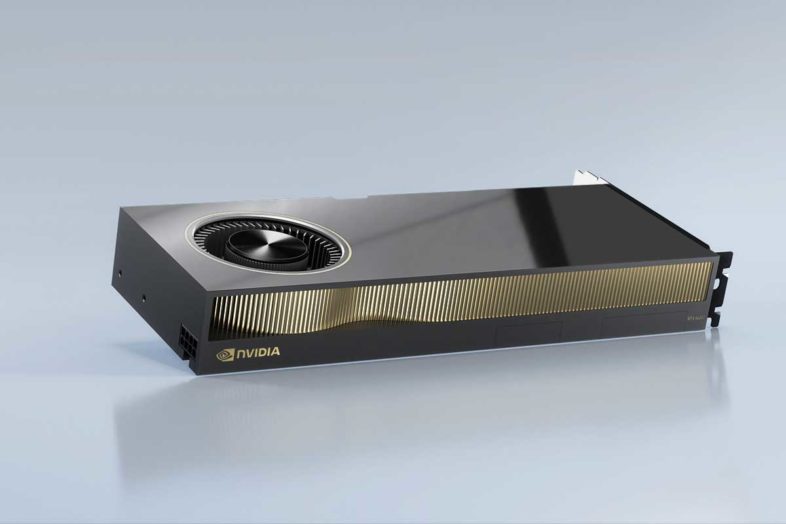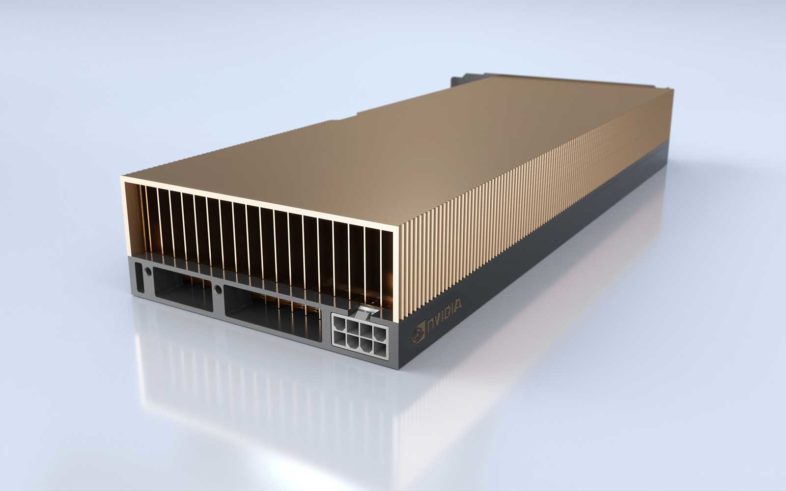NVidia is hosting another online GTC conference this week, to coincide with the launch of their new professional Ampere generation GPUs. These are professional variants of the chips that are in the GeForce 30 series cards that were launched last month. They appear to enable the last few shaders on the GA102 chip, and at 48GB, have twice the memory of the GeForce 3090.
 The RTX A6000 is their new top tier visualization card, (this is an extension of their former Quadro line) with 10,752 CUDA cores, and 48GB of GDDR6 memory with ECC. Like previous Quadro cards, it has four DisplayPort1.4 outputs, and unlike the GeForce 3090, fits into the standard double wide PCIe formfactor. It has a standard blower cooling fan with rear exhaust, no extra height, nor top mounted power connectors. It uses a standard 8pin PCIe power plug, and has a 300W TDP. This will make it easier to integrate with existing workstations than the oversized GeForce 3090, and allow it to fit vertically into 3U chassis. Like other Ampere generation cards, it supports PCIe Gen4, for 32GB/s of bandwidth in each direction. NVidia claims it has 40TFLOPS of processing power, but hasn’t released detailed frequency specifications. They list it as having 768GB/s of memory bandwidth, and the option of linking two cards over NVLink at 112GB/s. It lists having 1 NVEnc video encoder, and two NVDec decoders, which is interesting, but I have no further details on that aspect, as it was just in the literature, and not the press briefing.
The RTX A6000 is their new top tier visualization card, (this is an extension of their former Quadro line) with 10,752 CUDA cores, and 48GB of GDDR6 memory with ECC. Like previous Quadro cards, it has four DisplayPort1.4 outputs, and unlike the GeForce 3090, fits into the standard double wide PCIe formfactor. It has a standard blower cooling fan with rear exhaust, no extra height, nor top mounted power connectors. It uses a standard 8pin PCIe power plug, and has a 300W TDP. This will make it easier to integrate with existing workstations than the oversized GeForce 3090, and allow it to fit vertically into 3U chassis. Like other Ampere generation cards, it supports PCIe Gen4, for 32GB/s of bandwidth in each direction. NVidia claims it has 40TFLOPS of processing power, but hasn’t released detailed frequency specifications. They list it as having 768GB/s of memory bandwidth, and the option of linking two cards over NVLink at 112GB/s. It lists having 1 NVEnc video encoder, and two NVDec decoders, which is interesting, but I have no further details on that aspect, as it was just in the literature, and not the press briefing.
 The A40 is a passively cooled card, targeted at server installation, but with three DisplayPort outputs, unlike their previous Tesla cards in that segment. It is clocked slightly lower than the similar Quadro card, but with the same 10,752 CUDA cores, and 48GB of GDDR6 ECC memory. It has the same 8pin power connector, PCIe 4.0 and NVLink specs, and slightly lower memory bandwidth, at 696GB/s, due to lower frequencies. It also lists 1 video encoder and 2 decoders, when I would have expected the reverse for a virtual workstation card.
The A40 is a passively cooled card, targeted at server installation, but with three DisplayPort outputs, unlike their previous Tesla cards in that segment. It is clocked slightly lower than the similar Quadro card, but with the same 10,752 CUDA cores, and 48GB of GDDR6 ECC memory. It has the same 8pin power connector, PCIe 4.0 and NVLink specs, and slightly lower memory bandwidth, at 696GB/s, due to lower frequencies. It also lists 1 video encoder and 2 decoders, when I would have expected the reverse for a virtual workstation card.
The Quadro cards have always been targeted at professionals at a steep price premium over similarly powerful gaming cards, and the A6000 follows that pattern. 10bit color output used to be the main differentiating factor that mattered to M&E users, but HDR has necessitated that 10bit and higher color be supported in consumer hardware now, so that is no longer a feature limited to professional cards. Quadro cards are still the only option for using adaptors like 3D Vision Pro, and QuadroSyncII to lock card outputs together and match them to other hardware. This is key for workflows like video walls, and in-camera VFX, where live renders projected behind foreground actors replace green screen shots. The output is generated by multiple cards, and has to be output in sync to prevent tearing, and genlocked to the camera for best imaging sensor performance.
But for the average video editor or VFX artist, most of their needs can now be met with a GeForce solution. The Quadro line does offer longer warranties and driver support, hopefully leading to better system reliability in the long haul. The cards are usually clocked more conservatively, for better thermal performance and longer peak processing times before throttling takes place. They also usually offer better integration from top end workstation providers, who have been including Quadro GPUs in their products for many years now. So my recommendation is to make sure you know why you need a Quadro over a GeForce card before you invest that much money in one. But if you do need the features and performance that top end Quadro cards bring to the table, I wouldn’t consider getting one that wasn’t based on the Ampere architecture. Obviously there is only one option at the moment with the A6000, but I am confident that they will fill out the lower tiers in the near future.
The other major announcements for this event are software based. The first is NVidia’s Omniverse software package, which allows 3D artists and users to share data between various applications, both on their systems, and across the world. Users can be working on different aspects of a 3D project, in different programs, and Omniverse allows them to collaborate together far more seamlessly than has been possible up to this point. Omniverse is a framework of software tools and functions, instead of being a single service or application, and covers everything from 3D data types to rendering options. They are just getting started with it in this initial release, and surely their partners will build on that framework to offer all sorts of other functionality. NVidia is also announcing a Cloud based VR service called CloudXR. It currently runs on AWS, and offers low latency VR and AR viewing without needing a local VR capable workstation.

